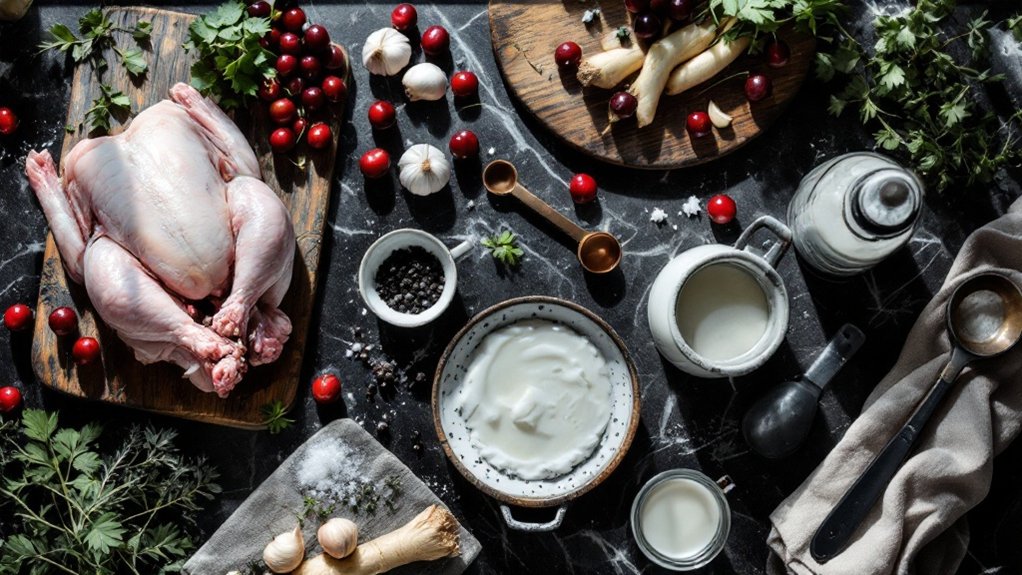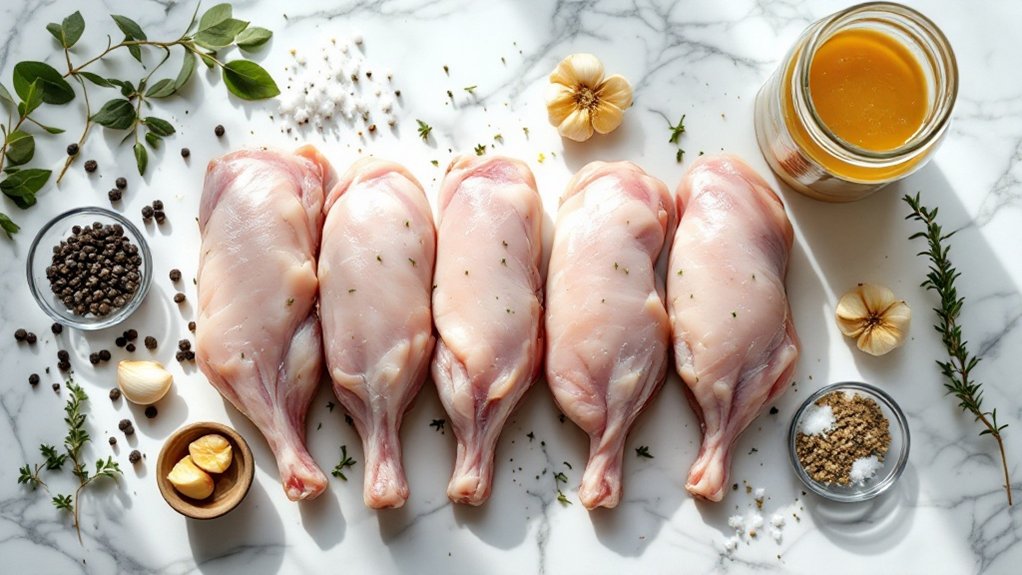
By chance, you’ve discovered one of French cuisine’s most treasured dishes on your quest for elevated keto dining. Duck confit, with its impossibly crispy skin and melt-in-your-mouth meat, transforms an ordinary dinner into an elegant affair. When paired with velvety celeriac puree and a tart cherry reduction, this dish proves that following a ketogenic lifestyle doesn’t mean sacrificing sophisticated flavors. The origins of this remarkable combination reveal an even more fascinating story.

However, if you’re preparing to make duck confit, you’ll want to capture those mouthwatering moments with beautiful photos that’ll make everyone’s taste buds tingle.
When you’re plating your perfectly crispy duck leg alongside that silky celeriac puree, take a moment to position your dish near natural light.
You’ll want to showcase how the cherry reduction glistens as it cascades down the golden-brown skin, and don’t forget to capture the delicate wisps of steam rising from the plate.
These images will help preserve the memory of your culinary masterpiece and inspire others to try their hand at this classic French dish.
History
While many consider duck confit a sophisticated French delicacy today, this preservation method originated from humble beginnings in the Gascony region of southwest France, where resourceful farmers developed the technique out of necessity.
You’ll find that these clever folks discovered they could preserve their precious duck meat through the winter months by slowly cooking it in its own fat, then storing it in earthenware crocks sealed with more fat.
When you imagine life before refrigeration, you can appreciate how this method wasn’t just about creating tender, flavorful meat – it was about survival.
The technique has been passed down through generations, and while you mightn’t need to preserve your food this way anymore, you’re participating in centuries of culinary tradition every time you prepare duck confit.
Recipe

Duck confit is a classic French preparation where duck legs are salt-cured and then slowly cooked in their own fat until meltingly tender. This centuries-old preservation technique was traditionally used to store meat before refrigeration, but today it’s celebrated as one of the most luxurious ways to prepare duck.
The process of making duck confit requires patience but rewards with incredibly rich, tender meat that practically falls off the bone. The duck legs are first cured with salt and aromatics, then gently poached in duck fat until the meat becomes succulent and the skin turns golden brown. The resulting dish can be served immediately or stored in the cooking fat for several weeks.
- 4 duck legs
- 4-6 cups duck fat
- 3 tablespoons kosher salt
- 4 garlic cloves, crushed
- 2 bay leaves
- 6 sprigs fresh thyme
- 1 teaspoon black peppercorns
- 2 tablespoons dried juniper berries
Mix salt with crushed garlic, herbs, and spices, then thoroughly coat the duck legs with this mixture. Refrigerate for 24-48 hours. Rinse the cure off the legs and pat them dry. Preheat oven to 250°F (120°C). Place the duck legs in a deep baking dish and cover completely with melted duck fat. Cook for 2.5-3 hours until the meat is very tender and easily pulls away from the bone. Remove from the oven and let cool in the fat.
For best results, allow the confit to rest in its cooking fat for at least 24 hours before serving to develop deeper flavors.
While traditional confit requires duck fat, you can substitute with a mixture of olive oil and lard, though the flavor will be slightly different. To reduce fat content, remove the skin before serving and pair with fresh, acidic ingredients like vinaigrette-dressed greens or pickled vegetables to balance the richness.
Final Thoughts
Although mastering duck confit requires patience and practice, the rewards of creating this classic French dish will leave you with a deep sense of culinary accomplishment and a newfound appreciation for traditional cooking methods.
You’ll discover that the time invested in curing, cooking, and carefully crafting each element transforms a simple duck leg into something truly extraordinary.
As you share this dish with friends and family, you’ll notice their eyes light up at the first bite of crispy skin and tender meat, making all your efforts worthwhile.
While the process might seem daunting at first, you’ll find that each time you prepare duck confit, you’ll gain more confidence and develop an even deeper connection to the rich culinary heritage this dish represents.


